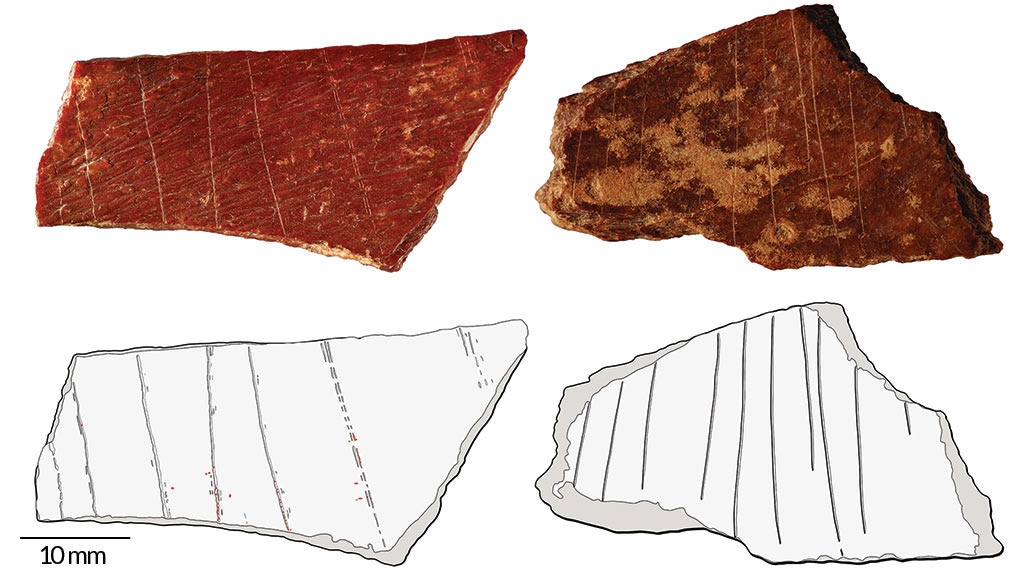
SYMBOL LIFE These two bone fragments found in northern China contain engraved lines, some marked with red pigment (red dots in left line drawing), making them the oldest examples of symbolic behavior in East Asia, researchers say.
F. d’Errico and L. Doyon, Antiquity 2019
Lines engraved between 125,000 and 105,000 years ago on two animal bones found in northern China held some sort of meaning for their makers, researchers say.
These ancient markings provide the oldest evidence of symbolic activity by humans or our close evolutionary relatives in East Asia, says a team led by archaeologists Zhanyang Li and Luc Doyon, both of Shandong University in Jinan, China. A mysterious Stone Age population called Denisovans, which had close genetic ties to Neandertals, may have carved sets of parallel lines into the pair of bone fragments, the scientists suggest in the August Antiquity.
Denisovans inhabited East Asia at the same time that someone carved lines into bones at northern China’s Lingjing site (SN: 3/2/19, p. 11). But either Homo sapiens or Neandertals, who also left behind Stone Age creations with apparent symbolic meanings (SN: 3/17/18, p. 6), might instead have modified the Lingjing bones.
“Nonetheless, the two objects from Lingjing suggest that symbolic capacities were within the realm of cognitive abilities of [Homo] species that lived before and during the evolution of Homo sapiens in Africa,” Doyon says.
Abstract markings on the Lingjing bones resemble engraved lines on roughly 100,000-year-old pigment chunks from South Africa (SN Online: 6/12/09), says archaeologist Paul Pettitt of Durham University in England. “As Homo sapiens was responsible for that early symbolism in Africa, and Neandertals were responsible for such in Europe, it is a fascinating possibility that these [Chinese] examples were created by another Homo species,” Pettitt says.
Until now, a roughly 40,000-year-old stone containing a set of parallel and intersecting engraved lines, previously found at another northern Chinese site, represented the oldest evidence of symbolic behavior in East Asia. An engraved geometric design on a roughly half-million-year-old seashell found on an Indonesian island stands as the oldest example of symbolic behavior anywhere in the world (SN: 12/27/14, p. 6). Researchers suspect the now-extinct hominid species Homo erectus carved that pattern. The oldest known drawing, another type of symbolic behavior, dates to around 73,000 years ago in South Africa (SN: 10/13/18, p. 6).
Almost one-quarter of 227 animal bone fragments excavated at Lingjing between 2005 and 2015 display stone tool incisions typical of butchery, the researchers say. But that sample included two exceptions. Seven nearly parallel lines had been cut into a partial rib from an unidentified large, adult mammal. Microscopic analysis indicated that the lines were made with a sharp point that was run across the bone’s surface after it had suffered some damage from weathering. Special care was taken to create each of the first five lines with a single pass of the engraving tool. Red residue in four engraved lines indicated that a pigment had been smeared on the pattern, possibly to increase its visibility.
A second rib fragment from a large mammal contained 10 roughly parallel lines that had been sliced with a sharp stone point, probably in a single session, the researchers say. Engraving of these lines also occurred after the bone had been damaged by long exposure to the air. No pigment residue appeared on this specimen.
Estimated ages of the engraved bones relied on calculations of the time since sediment in which they were found was last exposed to sunlight.
Whoever cut lines into the Lingjing finds also fashioned animal bones into tools. Bone and antler artifacts found in the same sediment as the engraved ribs were likely used to retouch and sharpen used stone tools, Doyon and his colleagues reported in 2018.







